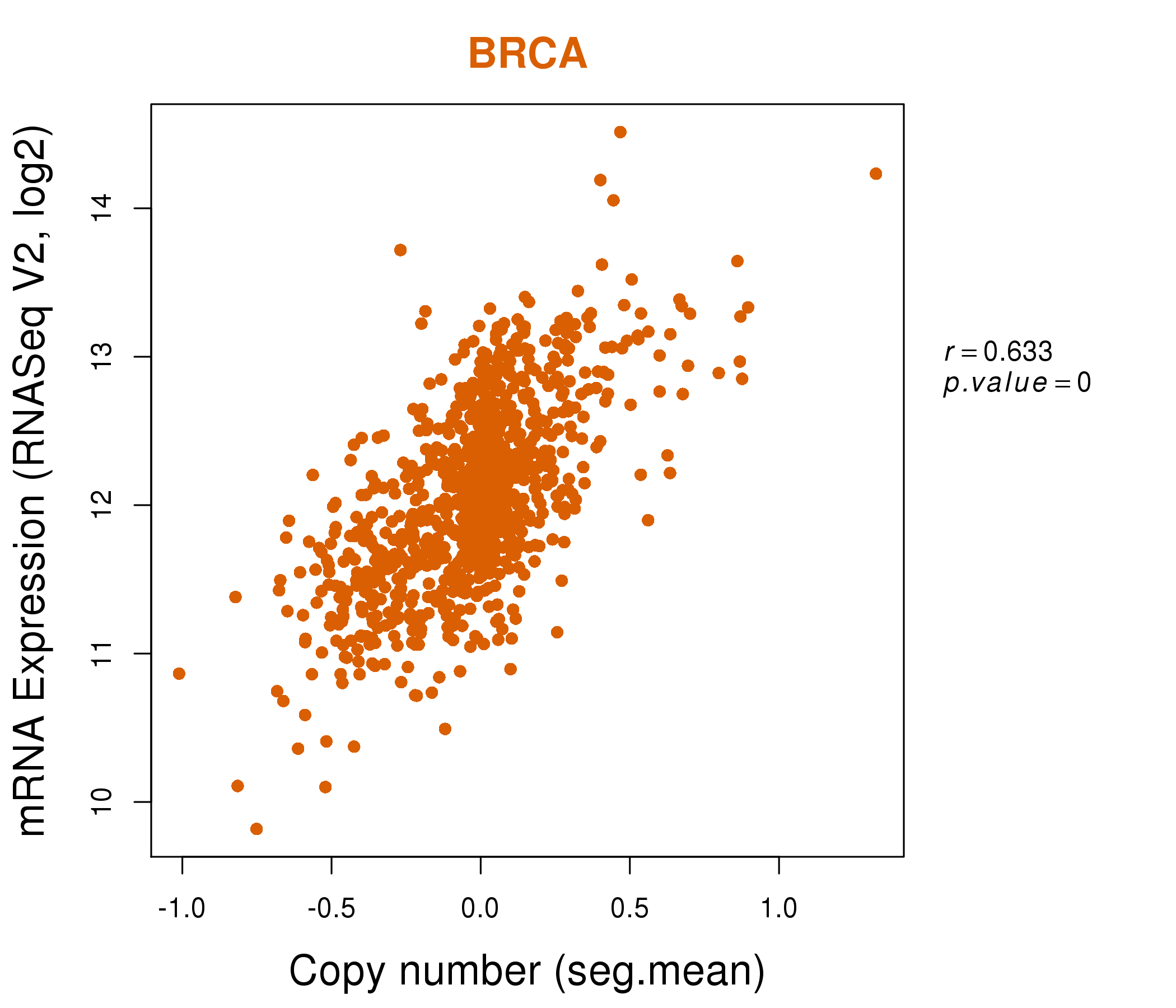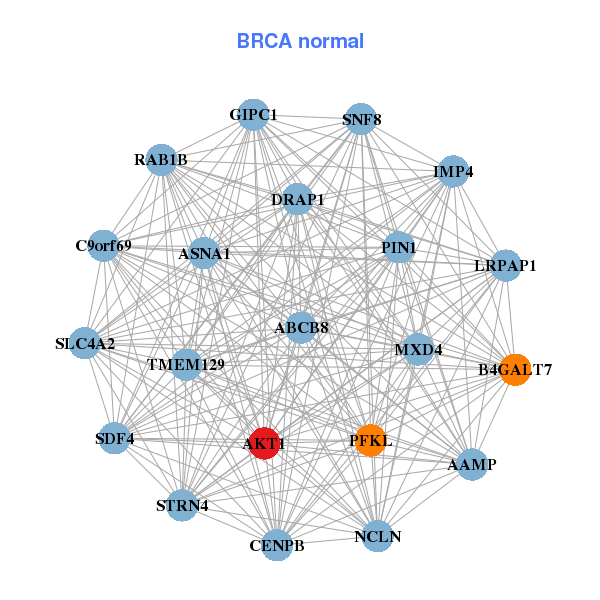|
||||||||||||||||||||
| |
| Phenotypic Information (metabolism pathway, cancer, disease, phenome) |
| |
| |
| Gene-Gene Network Information: Co-Expression Network, Interacting Genes & KEGG |
| |
|
| Gene Summary for AKT1 |
| Basic gene info. | Gene symbol | AKT1 |
| Gene name | v-akt murine thymoma viral oncogene homolog 1 | |
| Synonyms | AKT|CWS6|PKB|PKB-ALPHA|PRKBA|RAC|RAC-ALPHA | |
| Cytomap | UCSC genome browser: 14q32.32 | |
| Genomic location | chr14 :105235686-105262080 | |
| Type of gene | protein-coding | |
| RefGenes | NM_001014431.1, NM_001014432.1,NM_005163.2, | |
| Ensembl id | ENSG00000142208 | |
| Description | AKT1mPKB alphaRAC-PK-alphaRAC-alpha serine/threonine-protein kinaseprotein kinase B alphaproto-oncogene c-Aktrac protein kinase alpha | |
| Modification date | 20141222 | |
| dbXrefs | MIM : 164730 | |
| HGNC : HGNC | ||
| Ensembl : ENSG00000142208 | ||
| HPRD : 01261 | ||
| Vega : OTTHUMG00000170795 | ||
| Protein | UniProt: P31749 go to UniProt's Cross Reference DB Table | |
| Expression | CleanEX: HS_AKT1 | |
| BioGPS: 207 | ||
| Gene Expression Atlas: ENSG00000142208 | ||
| The Human Protein Atlas: ENSG00000142208 | ||
| Pathway | NCI Pathway Interaction Database: AKT1 | |
| KEGG: AKT1 | ||
| REACTOME: AKT1 | ||
| ConsensusPathDB | ||
| Pathway Commons: AKT1 | ||
| Metabolism | MetaCyc: AKT1 | |
| HUMANCyc: AKT1 | ||
| Regulation | Ensembl's Regulation: ENSG00000142208 | |
| miRBase: chr14 :105,235,686-105,262,080 | ||
| TargetScan: NM_001014431 | ||
| cisRED: ENSG00000142208 | ||
| Context | iHOP: AKT1 | |
| cancer metabolism search in PubMed: AKT1 | ||
| UCL Cancer Institute: AKT1 | ||
| Assigned class in ccmGDB | A - This gene has a literature evidence and it belongs to cancer gene. | |
| References showing role of AKT1 in cancer cell metabolism | 1. Tenkerian C, Krishnamoorthy J, Mounir Z, Kazimierczak U, Khoutorsky A, et al. (2015) mTORC2 balances Akt activation and eIF2alpha serine 51 phosphorylation to promote survival under stress. Mol Cancer Res. doi: 10.1158/1541-7786.MCR-15-0184-T. go to article 2. Zhang Y, Guo X, Xiong L, Yu L, Li Z, et al. (2014) Comprehensive analysis of microRNA-regulated protein interaction network reveals the tumor suppressive role of microRNA-149 in human hepatocellular carcinoma via targeting AKT-mTOR pathway. Mol Cancer 13: 253. doi: 10.1186/1476-4598-13-253. pmid: 4255446. go to article 3. Maurya AK, Vinayak M (2015) Quercetin regresses Dalton's lymphoma growth via suppression of PI3K/AKT signaling leading to upregulation of p53 and decrease in energy metabolism. Nutr Cancer 67: 354-363. doi: 10.1080/01635581.2015.990574. go to article 4. Villar VH, Merhi F, Djavaheri-Mergny M, Duran RV (2015) Glutaminolysis and autophagy in cancer. Autophagy: 0. doi: 10.1080/15548627.2015.1053680. go to article | |
| Top |
| Phenotypic Information for AKT1(metabolism pathway, cancer, disease, phenome) |
| Cancer | CGAP: AKT1 |
| Familial Cancer Database: AKT1 | |
| * This gene is included in those cancer gene databases. |
|
|
|
|
|
| . | ||||||||||||||
Oncogene 1 | ||||||||||||||||||||
| cf) number; DB name 1 Oncogene; http://nar.oxfordjournals.org/content/35/suppl_1/D721.long, 2 Tumor Suppressor gene; https://bioinfo.uth.edu/TSGene/, 3 Cancer Gene Census; http://www.nature.com/nrc/journal/v4/n3/abs/nrc1299.html, 4 CancerGenes; http://nar.oxfordjournals.org/content/35/suppl_1/D721.long, 5 Network of Cancer Gene; http://ncg.kcl.ac.uk/index.php, 6 http://www.nature.com/nature/journal/v490/n7418/full/nature11412.html, 7 http://www.nature.com/nature/journal/v497/n7447/full/nature12113.html, 8Therapeutic Vulnerabilities in Cancer; http://cbio.mskcc.org/cancergenomics/statius/ |
| KEGG_FC_GAMMA_R_MEDIATED_PHAGOCYTOSIS REACTOME_METABOLISM_OF_MRNA REACTOME_METABOLISM_OF_RNA | |
| OMIM | 114480; phenotype. 114500; phenotype. 164730; gene. 176920; phenotype. 615109; phenotype. |
| Orphanet | 201; Cowden syndrome. 744; Proteus syndrome. |
| Disease | KEGG Disease: AKT1 |
| MedGen: AKT1 (Human Medical Genetics with Condition) | |
| ClinVar: AKT1 | |
| Phenotype | MGI: AKT1 (International Mouse Phenotyping Consortium) |
| PhenomicDB: AKT1 | |
| Mutations for AKT1 |
| * Under tables are showing count per each tissue to give us broad intuition about tissue specific mutation patterns.You can go to the detailed page for each mutation database's web site. |
| There's no structural variation information in COSMIC data for this gene. |
| * From mRNA Sanger sequences, Chitars2.0 arranged chimeric transcripts. This table shows AKT1 related fusion information. |
| ID | Head Gene | Tail Gene | Accession | Gene_a | qStart_a | qEnd_a | Chromosome_a | tStart_a | tEnd_a | Gene_a | qStart_a | qEnd_a | Chromosome_a | tStart_a | tEnd_a |
| BC063408 | AKT1 | 1 | 157 | 14 | 105258934 | 105261851 | PPP3R1 | 154 | 268 | 2 | 68405988 | 68406102 | |
| Top |
| There's no copy number variation information in COSMIC data for this gene. |
| Top |
|
 |
| Top |
| Stat. for Non-Synonymous SNVs (# total SNVs=359) | (# total SNVs=10) |
 | 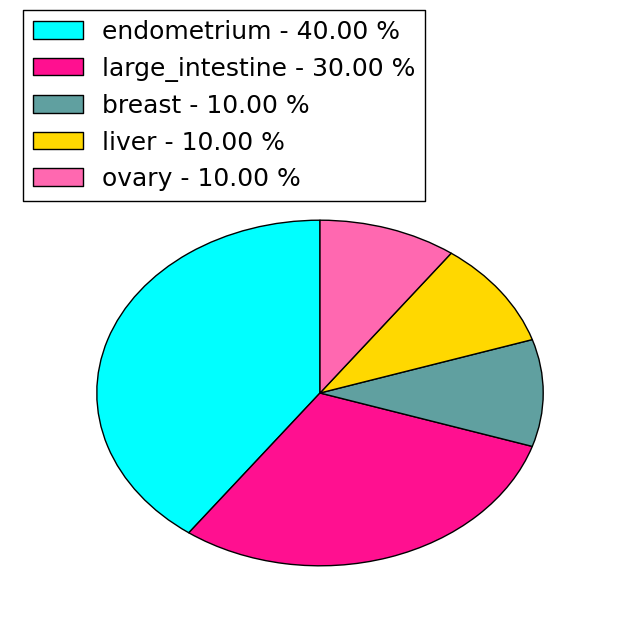 |
(# total SNVs=0) | (# total SNVs=0) |
| Top |
| * When you move the cursor on each content, you can see more deailed mutation information on the Tooltip. Those are primary_site,primary_histology,mutation(aa),pubmedID. |
| GRCh37 position | Mutation(aa) | Unique sampleID count |
| chr14:105246551-105246551 | p.E17K | 283 |
| chr14:105246445-105246445 | p.L52R | 5 |
| chr14:105243048-105243048 | p.Q79K | 2 |
| chr14:105239878-105239878 | p.D248H | 2 |
| chr14:105239419-105239419 | p.D323G | 2 |
| chr14:105239894-105239894 | p.E242E | 2 |
| chr14:105242063-105242063 | p.R121W | 2 |
| chr14:105242100-105242100 | p.D108D | 2 |
| chr14:105241437-105241437 | p.L181L | 2 |
| chr14:105239693-105239693 | p.K284K | 1 |
| Top |
|
 |
| Point Mutation/ Tissue ID | 1 | 2 | 3 | 4 | 5 | 6 | 7 | 8 | 9 | 10 | 11 | 12 | 13 | 14 | 15 | 16 | 17 | 18 | 19 | 20 |
| # sample | 2 | 20 | 9 | 1 | 3 | 2 | 1 | 1 | 1 | 1 | 5 | 5 | 1 | 8 | ||||||
| # mutation | 2 | 3 | 9 | 1 | 3 | 2 | 1 | 1 | 1 | 1 | 5 | 5 | 1 | 8 | ||||||
| nonsynonymous SNV | 2 | 7 | 1 | 2 | 2 | 1 | 1 | 1 | 1 | 3 | 4 | |||||||||
| synonymous SNV | 2 | 1 | 2 | 1 | 1 | 4 | 2 | 1 | 4 |
| cf) Tissue ID; Tissue type (1; BLCA[Bladder Urothelial Carcinoma], 2; BRCA[Breast invasive carcinoma], 3; CESC[Cervical squamous cell carcinoma and endocervical adenocarcinoma], 4; COAD[Colon adenocarcinoma], 5; GBM[Glioblastoma multiforme], 6; Glioma Low Grade, 7; HNSC[Head and Neck squamous cell carcinoma], 8; KICH[Kidney Chromophobe], 9; KIRC[Kidney renal clear cell carcinoma], 10; KIRP[Kidney renal papillary cell carcinoma], 11; LAML[Acute Myeloid Leukemia], 12; LUAD[Lung adenocarcinoma], 13; LUSC[Lung squamous cell carcinoma], 14; OV[Ovarian serous cystadenocarcinoma ], 15; PAAD[Pancreatic adenocarcinoma], 16; PRAD[Prostate adenocarcinoma], 17; SKCM[Skin Cutaneous Melanoma], 18:STAD[Stomach adenocarcinoma], 19:THCA[Thyroid carcinoma], 20:UCEC[Uterine Corpus Endometrial Carcinoma]) |
| Top |
| * We represented just top 10 SNVs. When you move the cursor on each content, you can see more deailed mutation information on the Tooltip. Those are primary_site, primary_histology, mutation(aa), pubmedID. |
| Genomic Position | Mutation(aa) | Unique sampleID count |
| chr14:105246551 | p.E17K,AKT1 | 23 |
| chr14:105242100 | p.D108D,AKT1 | 2 |
| chr14:105246445 | p.L52R,AKT1 | 2 |
| chr14:105242064 | p.T197T,AKT1 | 1 |
| chr14:105246469 | p.D44G,AKT1 | 1 |
| chr14:105240258 | p.I447L,AKT1 | 1 |
| chr14:105242084 | p.A177A,AKT1 | 1 |
| chr14:105237106 | p.D44N,AKT1 | 1 |
| chr14:105246470 | p.T443T,AKT1 | 1 |
| chr14:105240285 | p.L153P,AKT1 | 1 |
| * Copy number data were extracted from TCGA using R package TCGA-Assembler. The URLs of all public data files on TCGA DCC data server were gathered on Jan-05-2015. Function ProcessCNAData in TCGA-Assembler package was used to obtain gene-level copy number value which is calculated as the average copy number of the genomic region of a gene. |
 |
| cf) Tissue ID[Tissue type]: BLCA[Bladder Urothelial Carcinoma], BRCA[Breast invasive carcinoma], CESC[Cervical squamous cell carcinoma and endocervical adenocarcinoma], COAD[Colon adenocarcinoma], GBM[Glioblastoma multiforme], Glioma Low Grade, HNSC[Head and Neck squamous cell carcinoma], KICH[Kidney Chromophobe], KIRC[Kidney renal clear cell carcinoma], KIRP[Kidney renal papillary cell carcinoma], LAML[Acute Myeloid Leukemia], LUAD[Lung adenocarcinoma], LUSC[Lung squamous cell carcinoma], OV[Ovarian serous cystadenocarcinoma ], PAAD[Pancreatic adenocarcinoma], PRAD[Prostate adenocarcinoma], SKCM[Skin Cutaneous Melanoma], STAD[Stomach adenocarcinoma], THCA[Thyroid carcinoma], UCEC[Uterine Corpus Endometrial Carcinoma] |
| Top |
| Gene Expression for AKT1 |
| * CCLE gene expression data were extracted from CCLE_Expression_Entrez_2012-10-18.res: Gene-centric RMA-normalized mRNA expression data. |
 |
| Top |
| *RPPA protein expression data were extracted from TCPA (The Cancer Proteome Atlas). Normalized data based on replicated based normalization (RBN) was used to draw following figures. |
 |
 |
 |
| * Normalized gene expression data of RNASeqV2 was extracted from TCGA using R package TCGA-Assembler. The URLs of all public data files on TCGA DCC data server were gathered at Jan-05-2015. Only eight cancer types have enough normal control samples for differential expression analysis. (t test, adjusted p<0.05 (using Benjamini-Hochberg FDR)) |
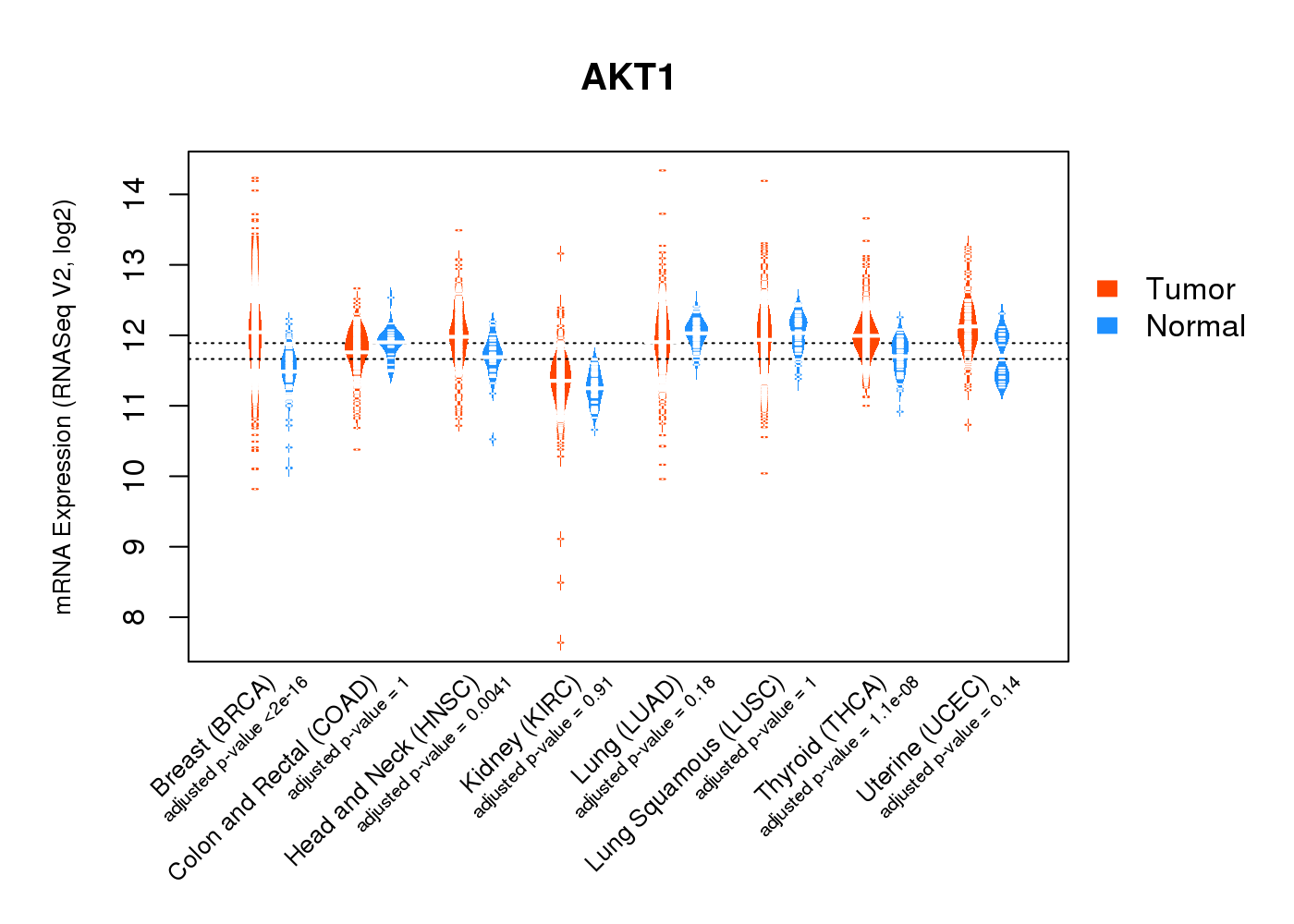 |
| Top |
| * This plots show the correlation between CNV and gene expression. |
: Open all plots for all cancer types
 |
|
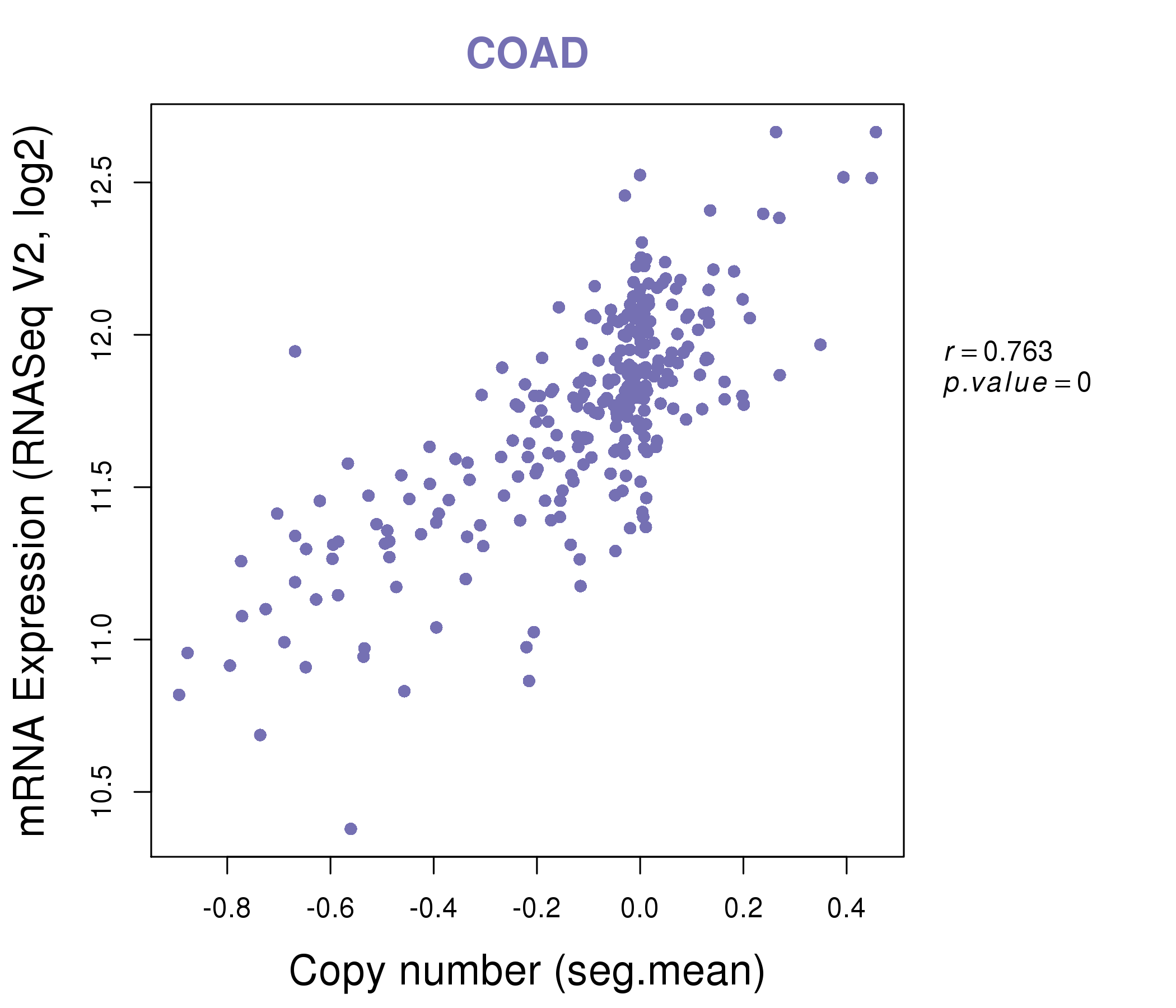 |
|
| Top |
| Gene-Gene Network Information |
| * Co-Expression network figures were drawn using R package igraph. Only the top 20 genes with the highest correlations were shown. Red circle: input gene, orange circle: cell metabolism gene, sky circle: other gene |
: Open all plots for all cancer types
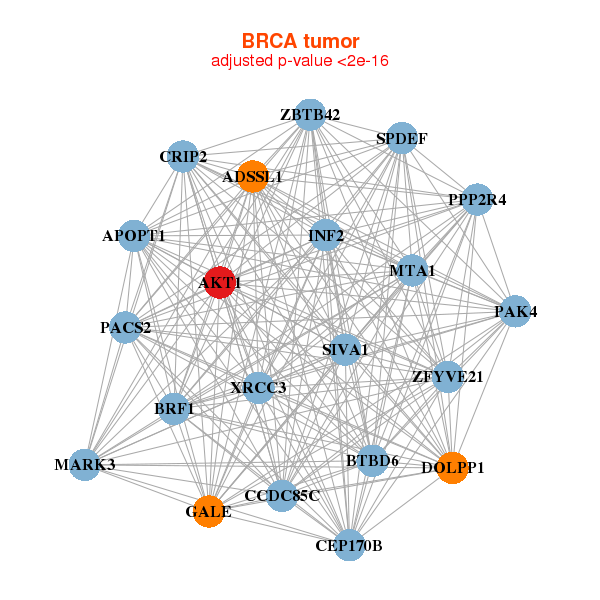 |
| ||||
| ADSSL1,AKT1,BRF1,BTBD6,APOPT1,CCDC85C,CRIP2, DOLPP1,GALE,INF2,CEP170B,MARK3,MTA1,PACS2, PAK4,PPP2R4,SIVA1,SPDEF,XRCC3,ZBTB42,ZFYVE21 | AAMP,ABCB8,AKT1,ASNA1,B4GALT7,C9orf69,CENPB, DRAP1,GIPC1,IMP4,LRPAP1,MXD4,NCLN,PFKL, PIN1,RAB1B,SDF4,SLC4A2,SNF8,STRN4,TMEM129 | ||||
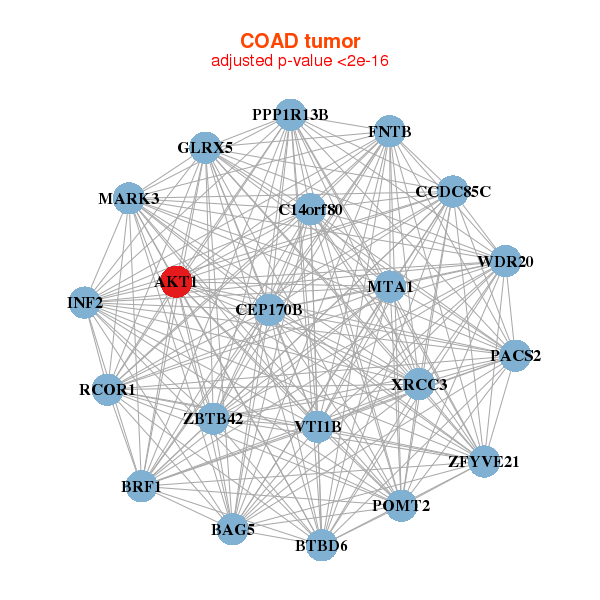 |
| ||||
| AKT1,BAG5,BRF1,BTBD6,C14orf80,CCDC85C,FNTB, GLRX5,INF2,CEP170B,MARK3,MTA1,PACS2,POMT2, PPP1R13B,RCOR1,VTI1B,WDR20,XRCC3,ZBTB42,ZFYVE21 | AKT1,ANKRD13B,DBN1,DLGAP4,EVI5L,JMJD8,KLC2, LOXL1,LPPR2,MAP4,NACC2,NCDN,NDE1,NFIX, PIP5K1C,PKN1,RANBP3,RBM38,SLC4A2,SPRYD3,ST5 |
| * Co-Expression network figures were drawn using R package igraph. Only the top 20 genes with the highest correlations were shown. Red circle: input gene, orange circle: cell metabolism gene, sky circle: other gene |
: Open all plots for all cancer types
| Top |
: Open all interacting genes' information including KEGG pathway for all interacting genes from DAVID
| Top |
| Pharmacological Information for AKT1 |
| DB Category | DB Name | DB's ID and Url link |
| Chemistry | BindingDB | P31749; -. |
| Chemistry | ChEMBL | CHEMBL3038463; -. |
| Chemistry | GuidetoPHARMACOLOGY | 1479; -. |
| Organism-specific databases | PharmGKB | PA24684; -. |
| Organism-specific databases | CTD | 207; -. |
| * Gene Centered Interaction Network. |
 |
| * Drug Centered Interaction Network. |
| DrugBank ID | Target Name | Drug Groups | Generic Name | Drug Centered Network | Drug Structure |
| DB00171 | v-akt murine thymoma viral oncogene homolog 1 | approved; nutraceutical | Adenosine triphosphate |  |  |
| DB01169 | v-akt murine thymoma viral oncogene homolog 1 | approved; investigational | Arsenic trioxide | 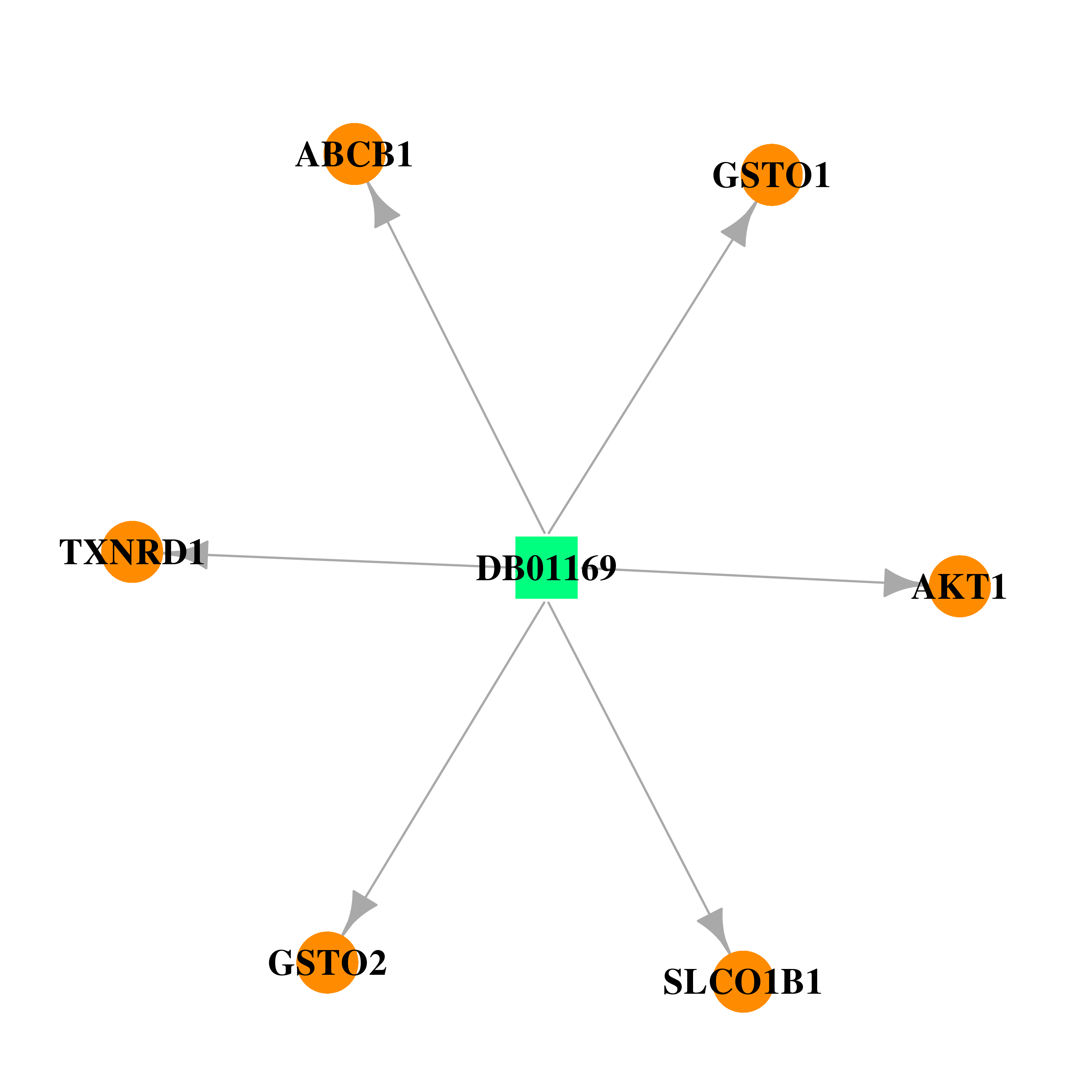 | 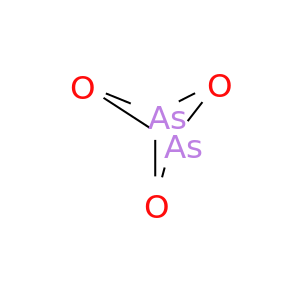 |
| DB01863 | v-akt murine thymoma viral oncogene homolog 1 | experimental | Inositol 1,3,4,5-Tetrakisphosphate | 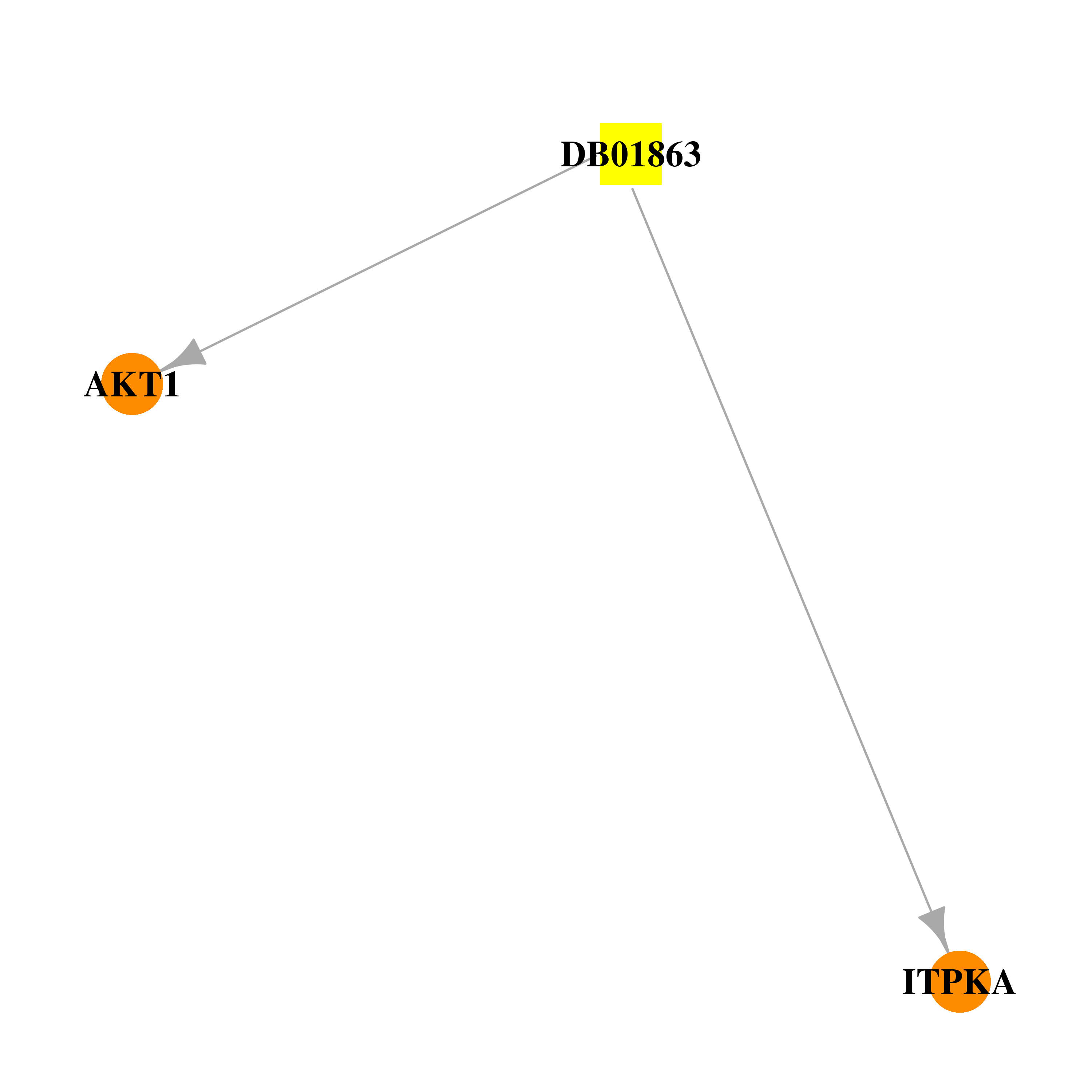 |  |
| DB07584 | v-akt murine thymoma viral oncogene homolog 1 | experimental | N-[2-(5-methyl-4H-1,2,4-triazol-3-yl)phenyl]-7H-pyrrolo[2,3-d]pyrimidin-4-amine | 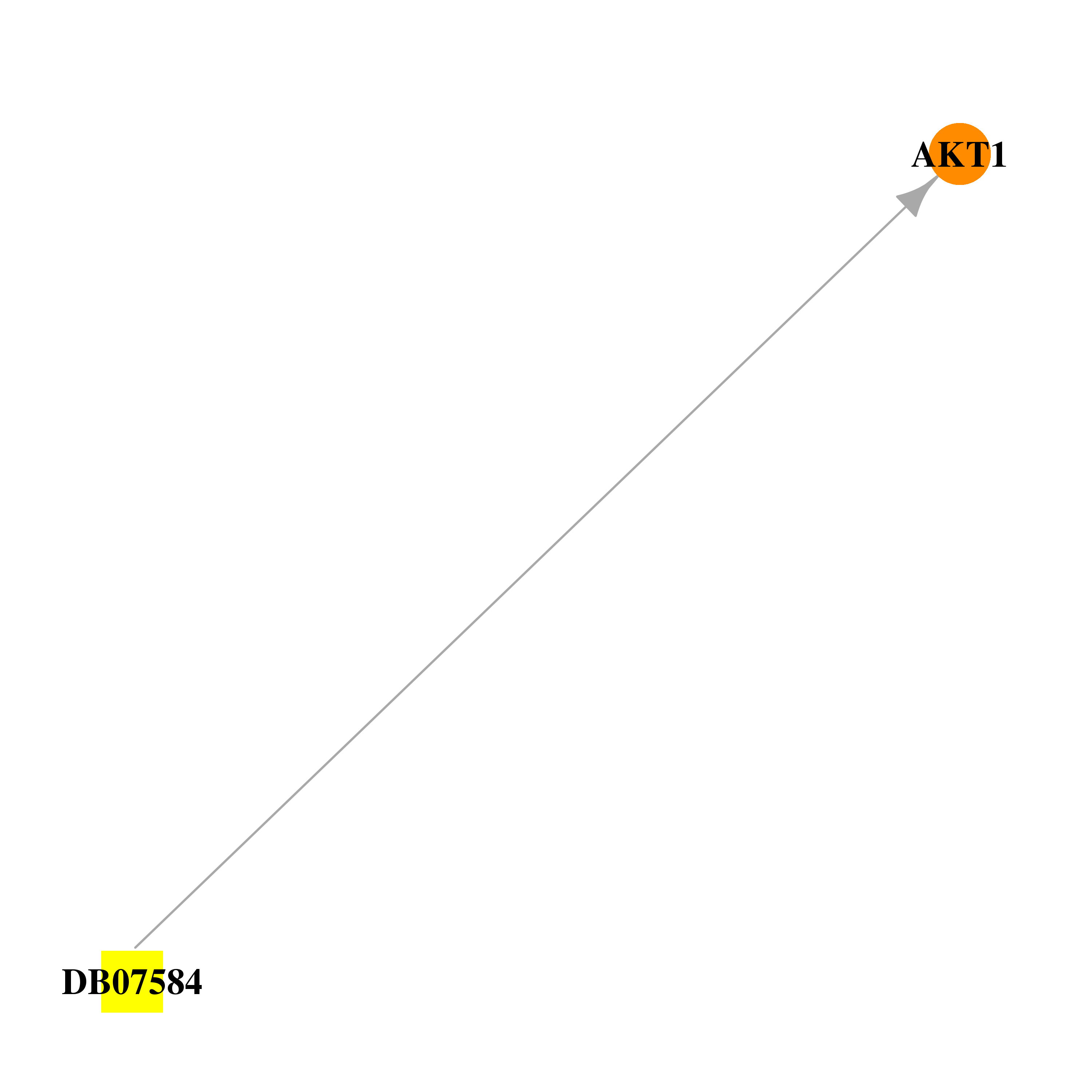 | 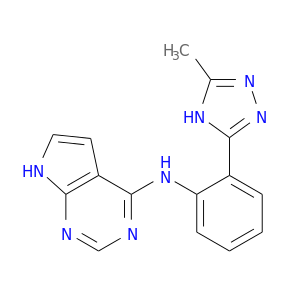 |
| DB07585 | v-akt murine thymoma viral oncogene homolog 1 | experimental | 5-(5-chloro-7H-pyrrolo[2,3-d]pyrimidin-4-yl)-4,5,6,7-tetrahydro-1H-imidazo[4,5-c]pyridine | 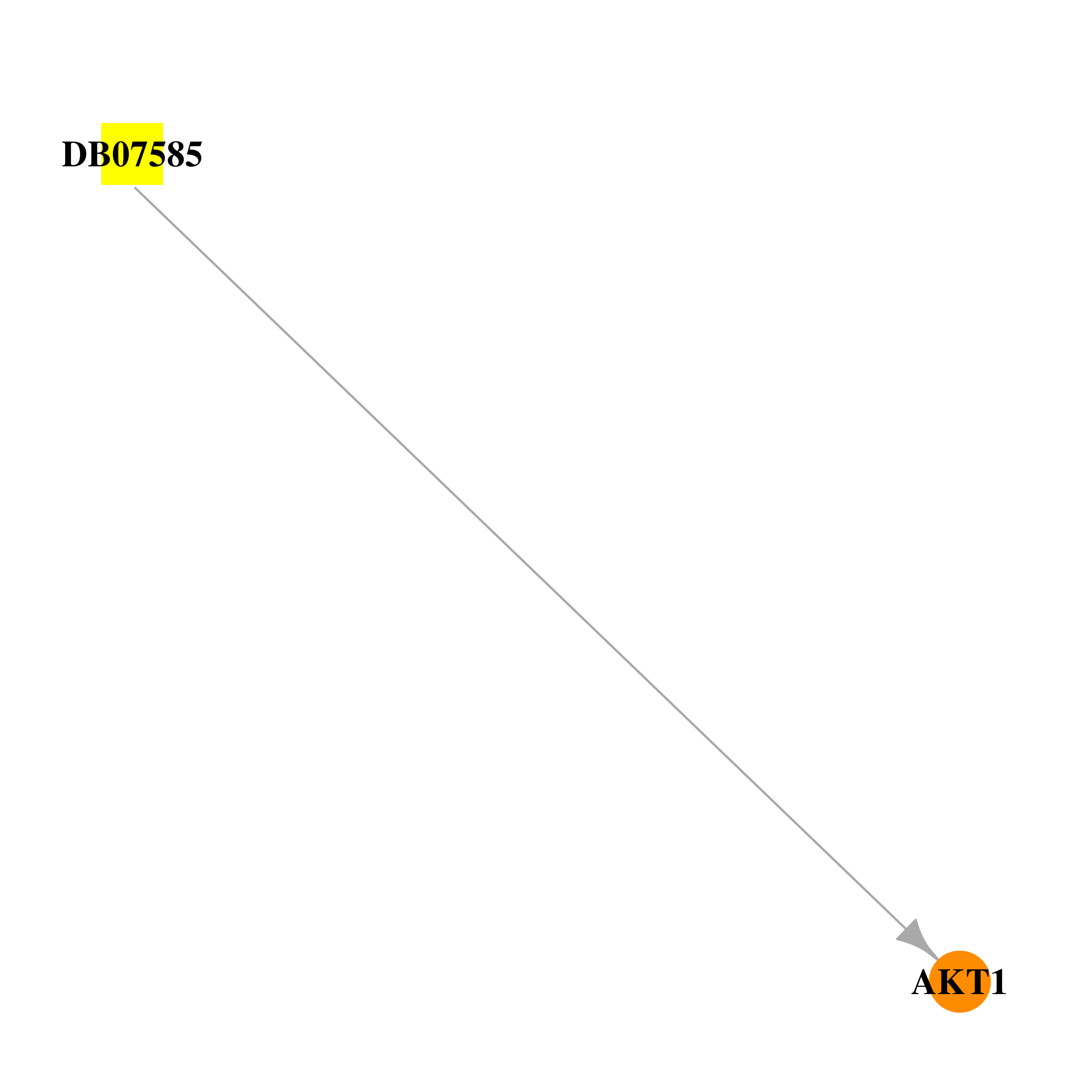 |  |
| DB00398 | v-akt murine thymoma viral oncogene homolog 1 | approved; investigational | Sorafenib |  | 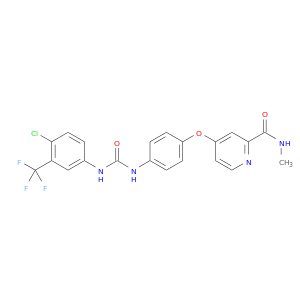 |
| DB00864 | v-akt murine thymoma viral oncogene homolog 1 | approved; investigational | Tacrolimus |  |  |
| DB00675 | v-akt murine thymoma viral oncogene homolog 1 | approved | Tamoxifen |  |  |
| DB00734 | v-akt murine thymoma viral oncogene homolog 1 | approved; investigational | Risperidone | 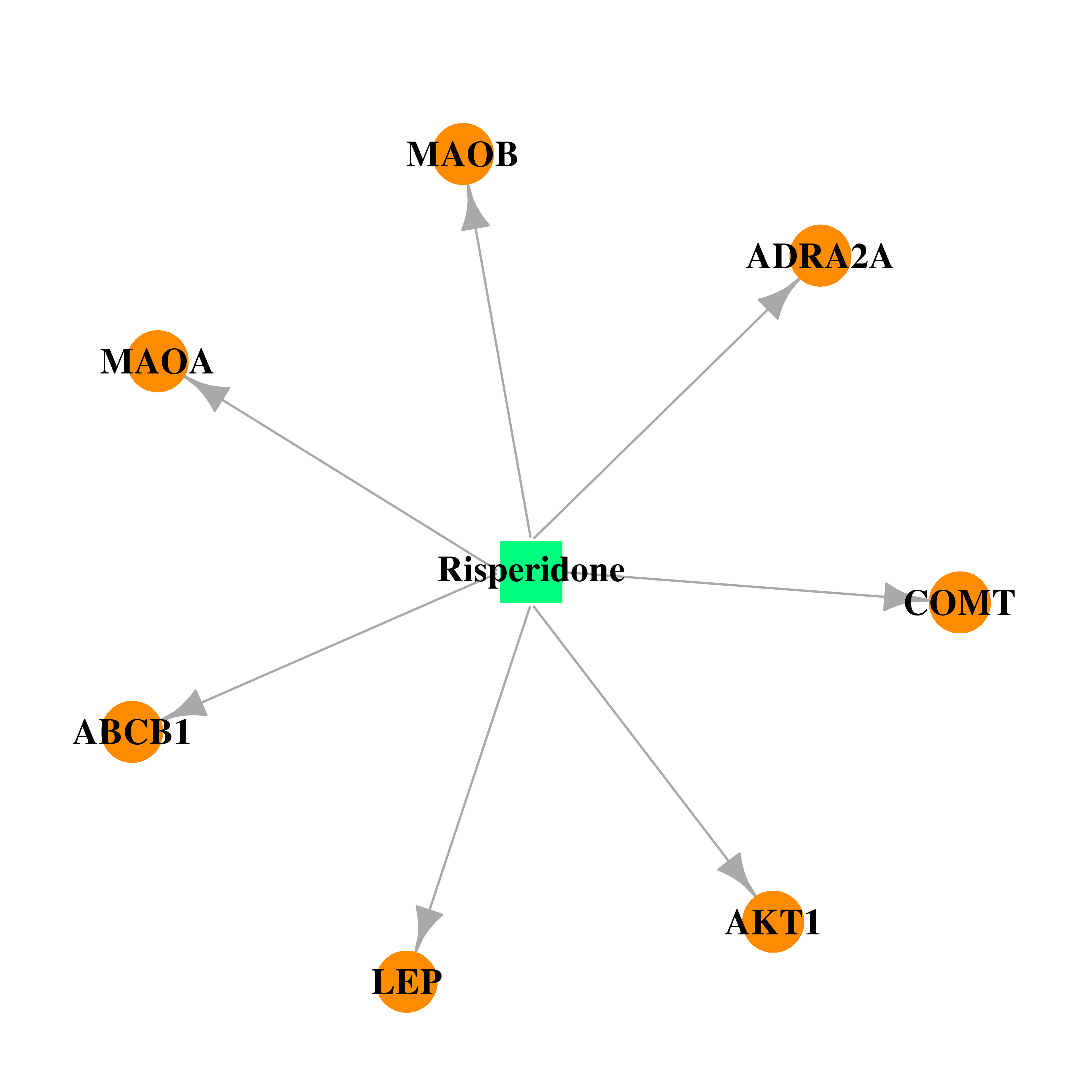 | 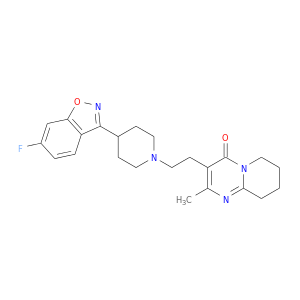 |
| DB00997 | v-akt murine thymoma viral oncogene homolog 1 | approved; investigational | Doxorubicin |  | 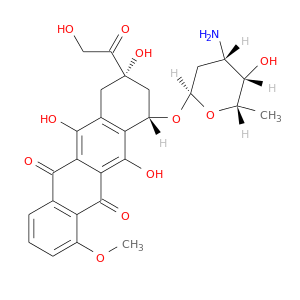 |
| DB00317 | v-akt murine thymoma viral oncogene homolog 1 | approved; investigational | Gefitinib |  |  |
| DB01259 | v-akt murine thymoma viral oncogene homolog 1 | approved; investigational | Lapatinib |  |  |
| DB00360 | v-akt murine thymoma viral oncogene homolog 1 | approved; investigational | Tetrahydrobiopterin | 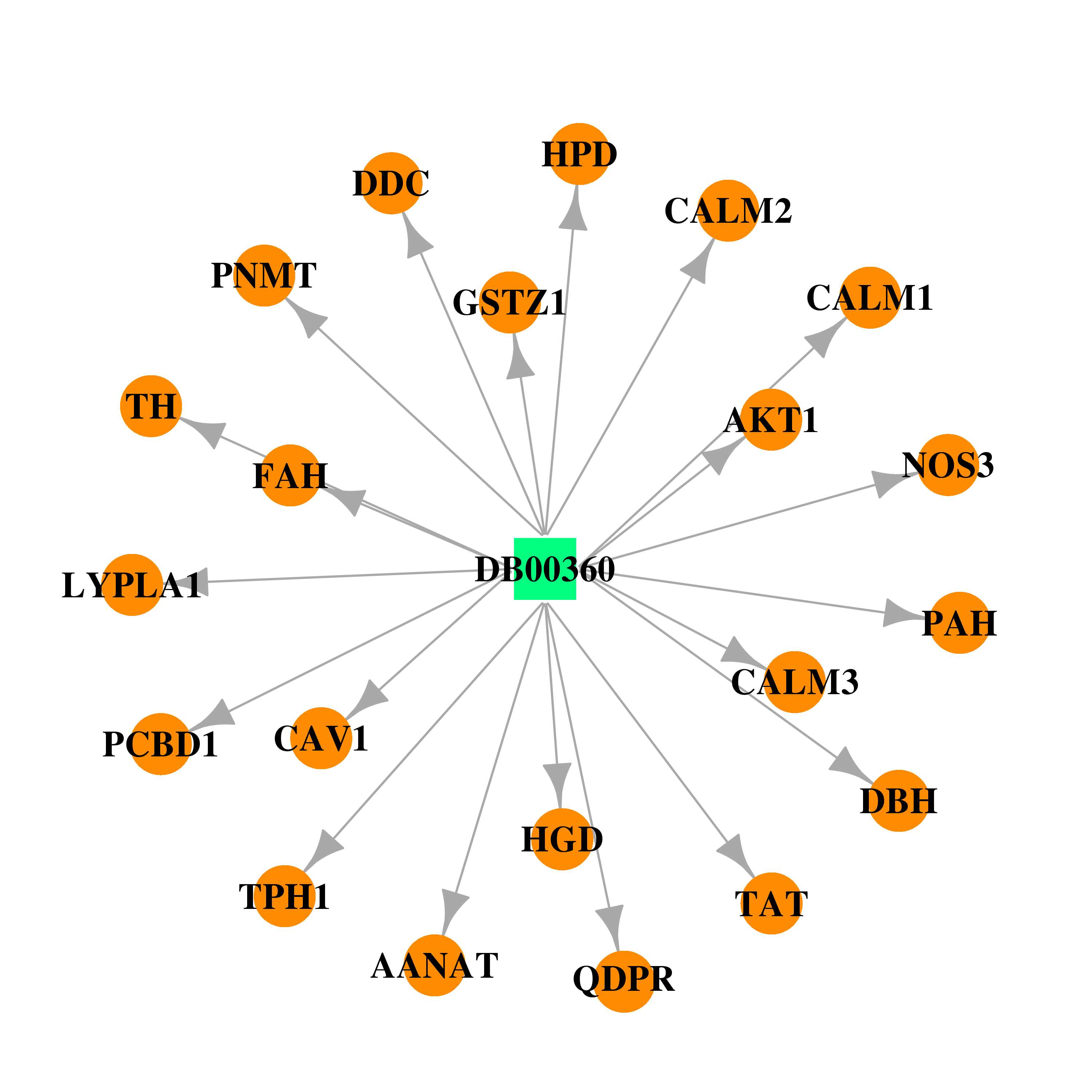 |  |
| DB00394 | v-akt murine thymoma viral oncogene homolog 1 | approved | Beclomethasone |  | 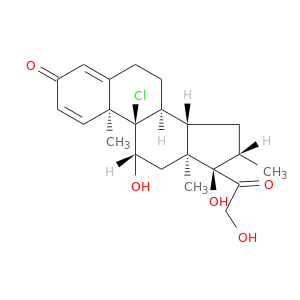 |
| DB00443 | v-akt murine thymoma viral oncogene homolog 1 | approved | Betamethasone |  | 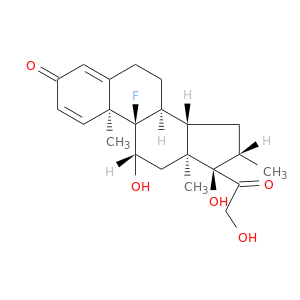 |
| DB01222 | v-akt murine thymoma viral oncogene homolog 1 | approved; investigational | Budesonide |  | 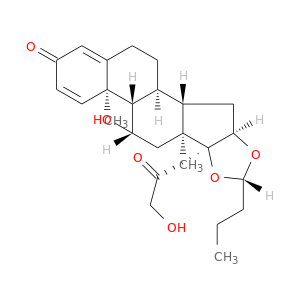 |
| DB01410 | v-akt murine thymoma viral oncogene homolog 1 | approved; investigational | Ciclesonide | 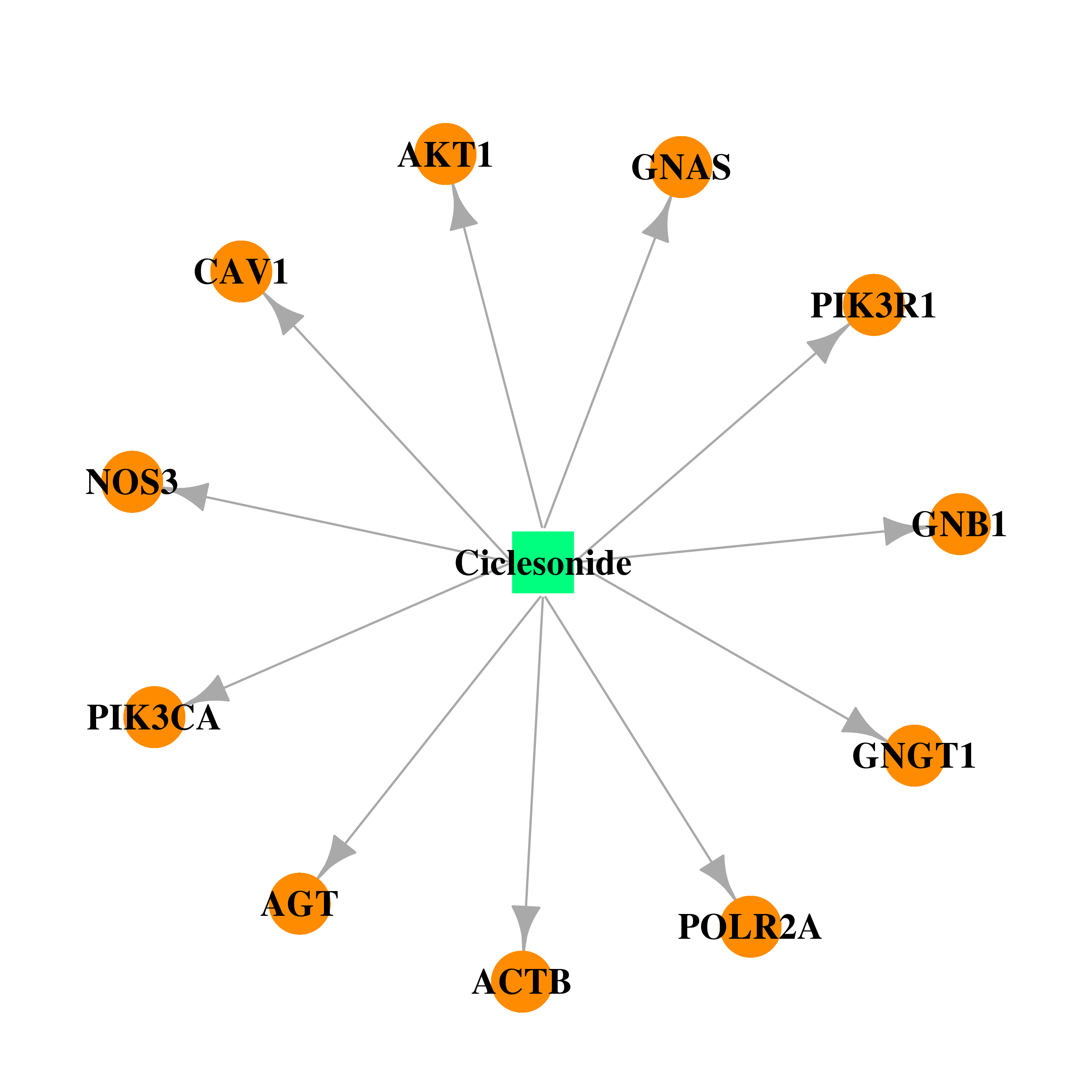 | 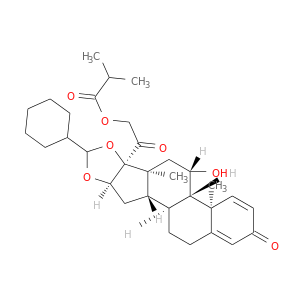 |
| DB01260 | v-akt murine thymoma viral oncogene homolog 1 | approved; investigational | Desonide |  |  |
| DB01234 | v-akt murine thymoma viral oncogene homolog 1 | approved; investigational | Dexamethasone | 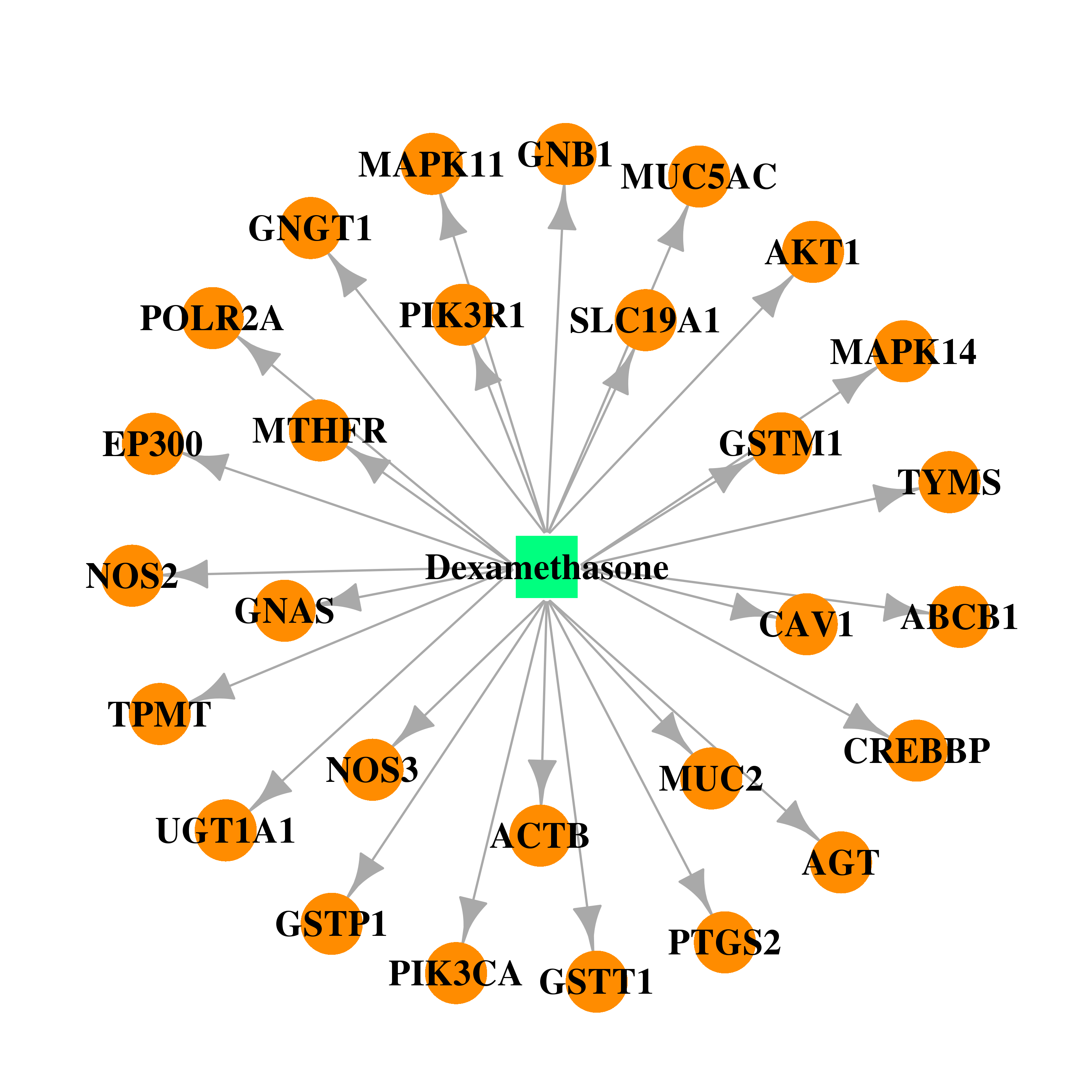 | 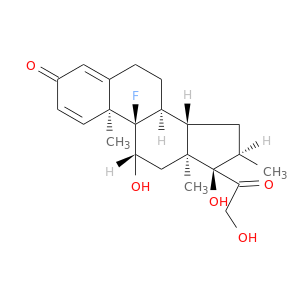 |
| DB00180 | v-akt murine thymoma viral oncogene homolog 1 | approved; investigational | Flunisolide |  | 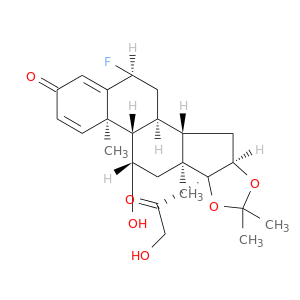 |
| DB00588 | v-akt murine thymoma viral oncogene homolog 1 | approved; investigational | Fluticasone Propionate | 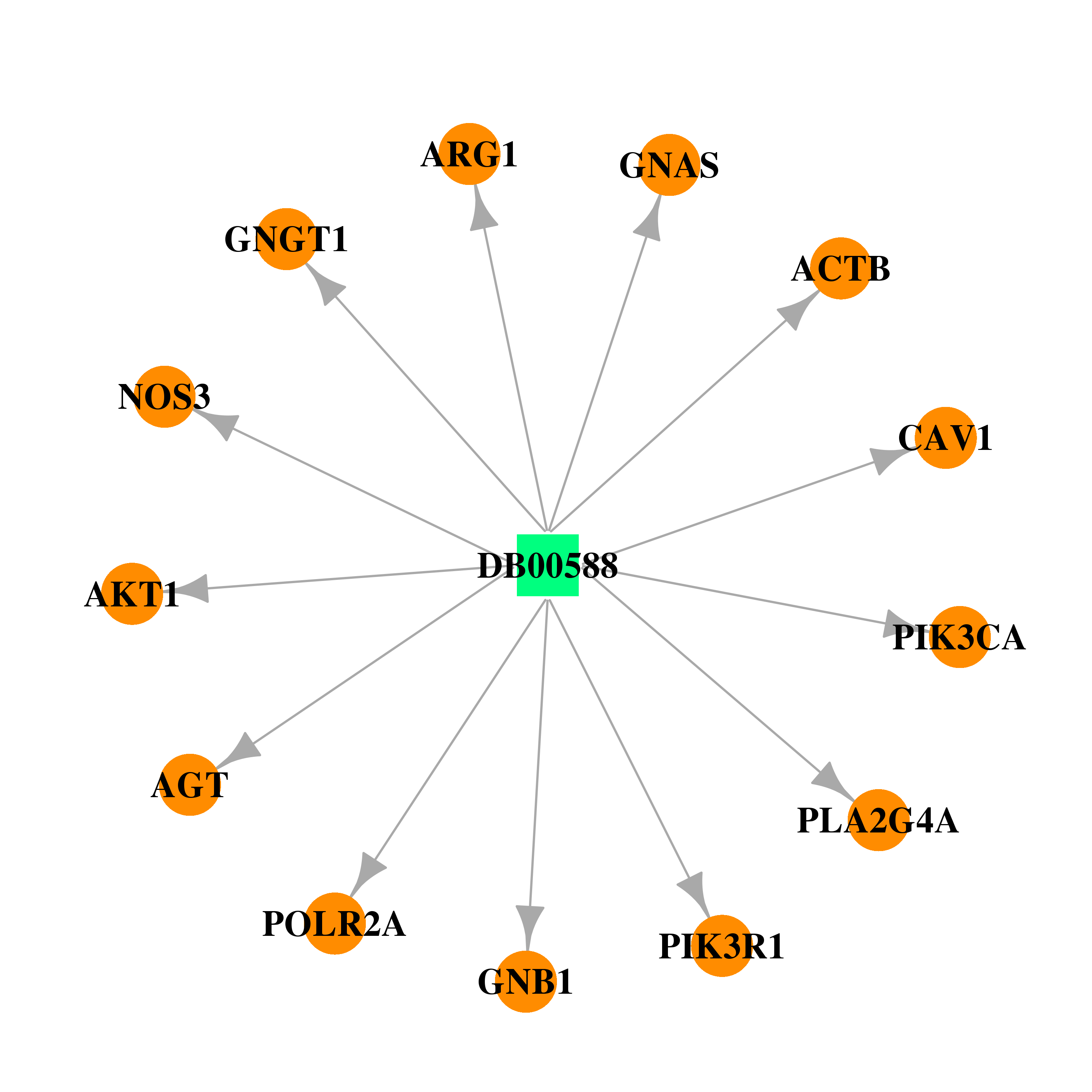 |  |
| DB00741 | v-akt murine thymoma viral oncogene homolog 1 | approved | Hydrocortisone |  |  |
| DB00959 | v-akt murine thymoma viral oncogene homolog 1 | approved | Methylprednisolone |  | 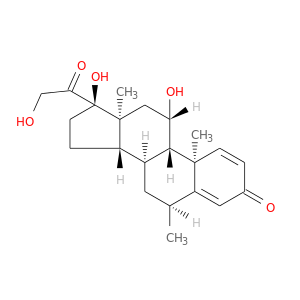 |
| DB00764 | v-akt murine thymoma viral oncogene homolog 1 | approved | Mometasone | 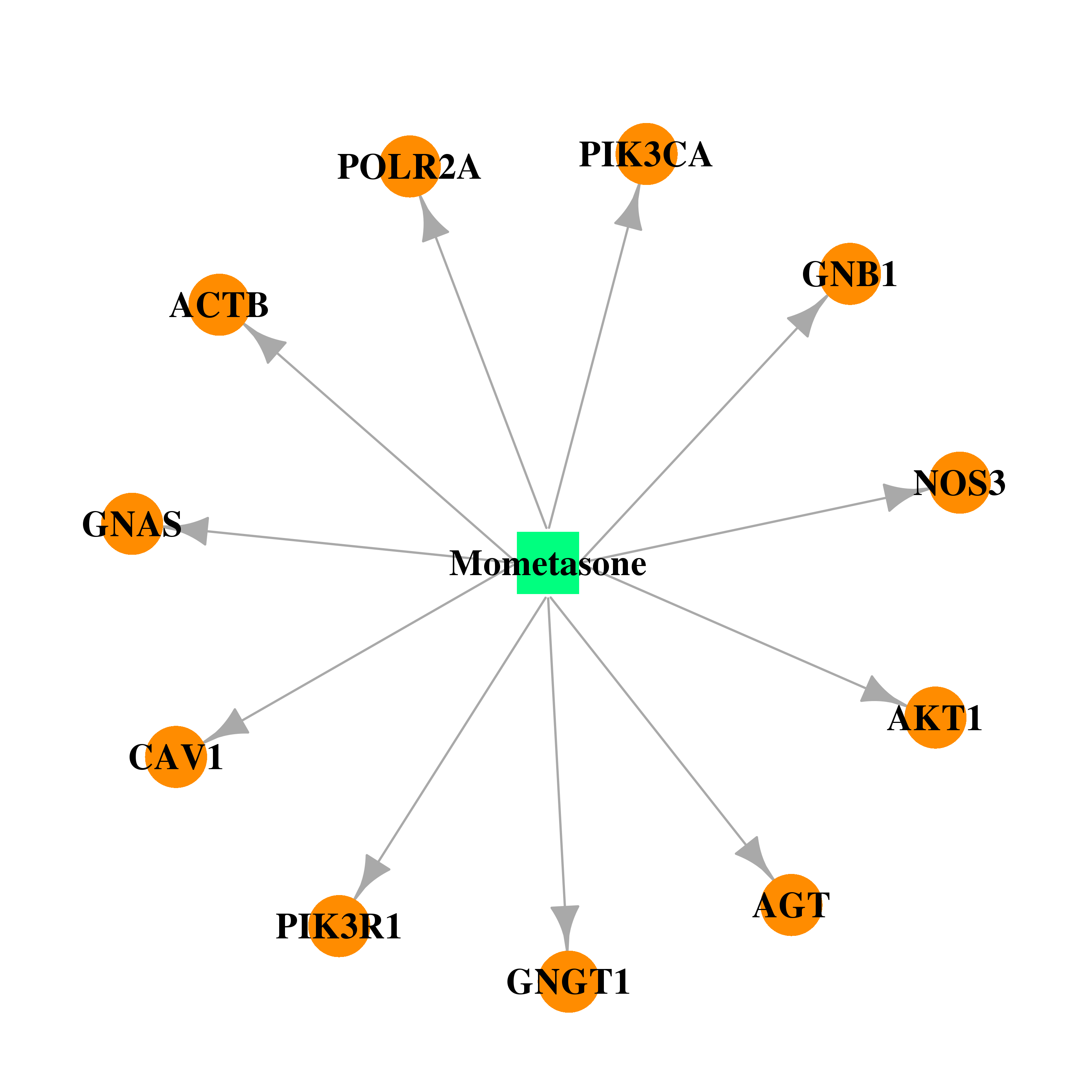 |  |
| DB01384 | v-akt murine thymoma viral oncogene homolog 1 | approved | Paramethasone |  | 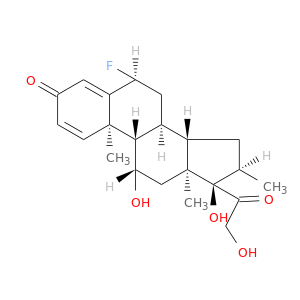 |
| DB00860 | v-akt murine thymoma viral oncogene homolog 1 | approved | Prednisolone | 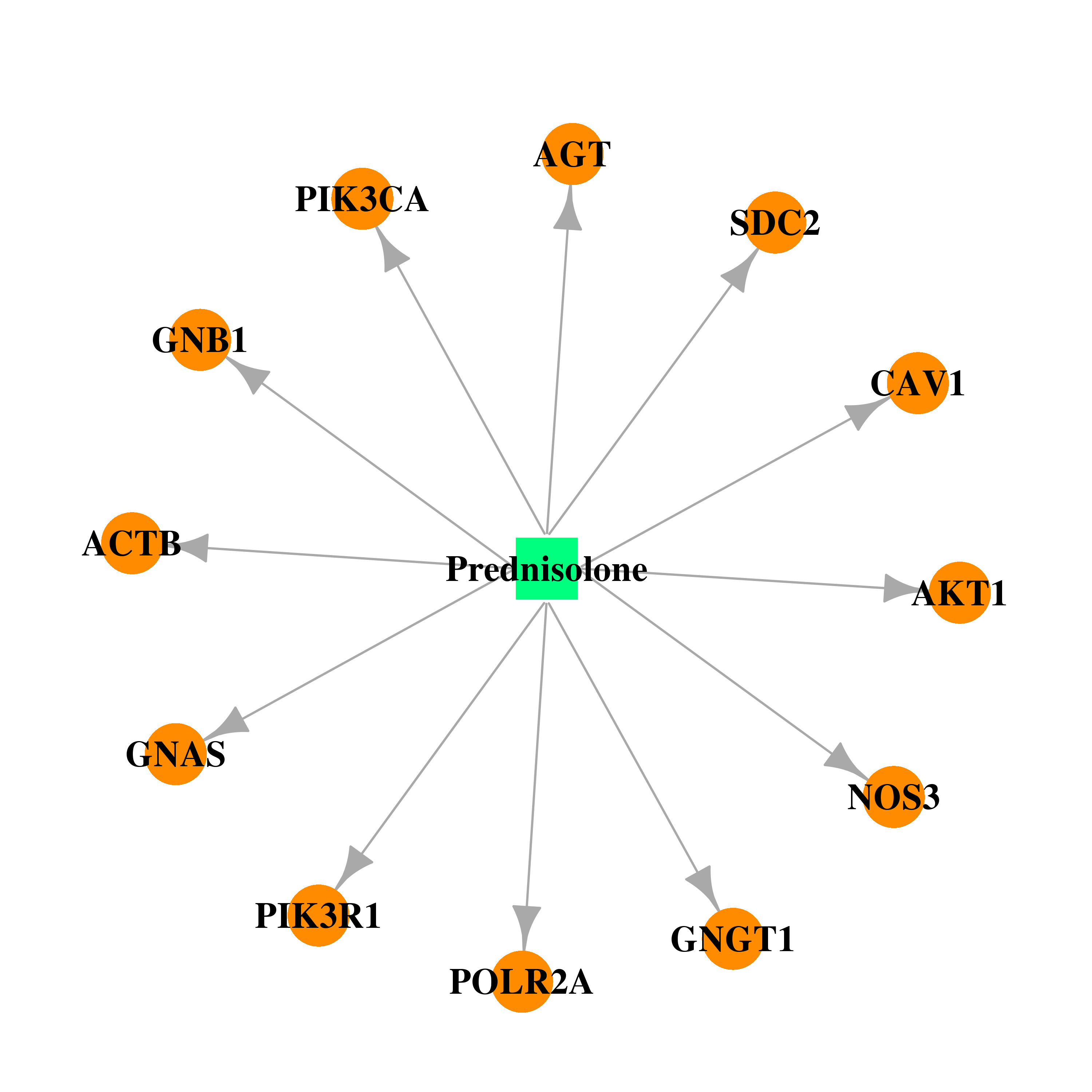 |  |
| DB00635 | v-akt murine thymoma viral oncogene homolog 1 | approved | Prednisone | 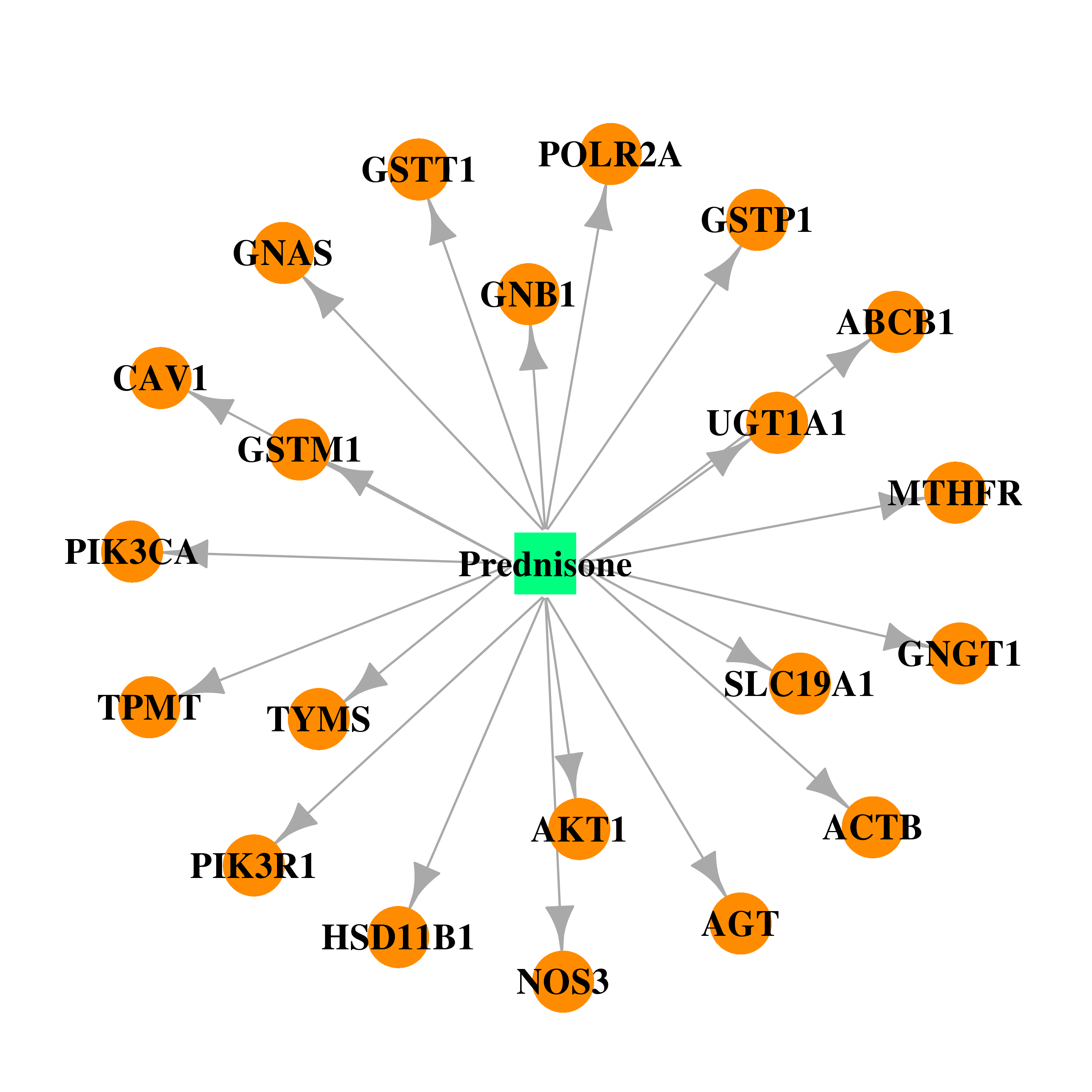 |  |
| DB00896 | v-akt murine thymoma viral oncogene homolog 1 | approved | Rimexolone |  |  |
| DB00620 | v-akt murine thymoma viral oncogene homolog 1 | approved | Triamcinolone |  |  |
| DB00877 | v-akt murine thymoma viral oncogene homolog 1 | approved; investigational | Sirolimus | 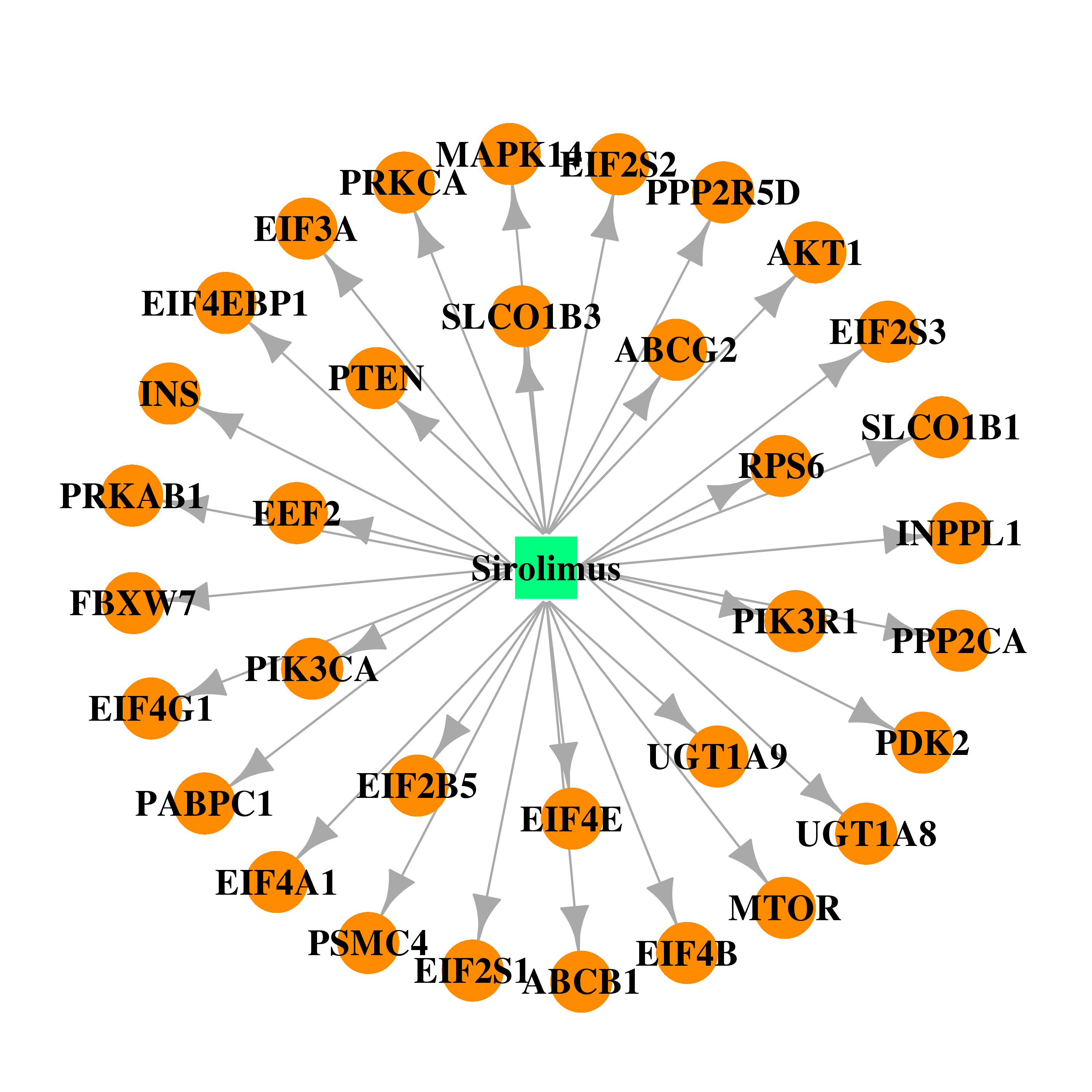 |  |
| DB00143 | v-akt murine thymoma viral oncogene homolog 1 | approved; nutraceutical | Glutathione |  |  |
| DB00122 | v-akt murine thymoma viral oncogene homolog 1 | approved; nutraceutical | Choline |  |  |
| DB00125 | v-akt murine thymoma viral oncogene homolog 1 | approved; nutraceutical | L-Arginine | 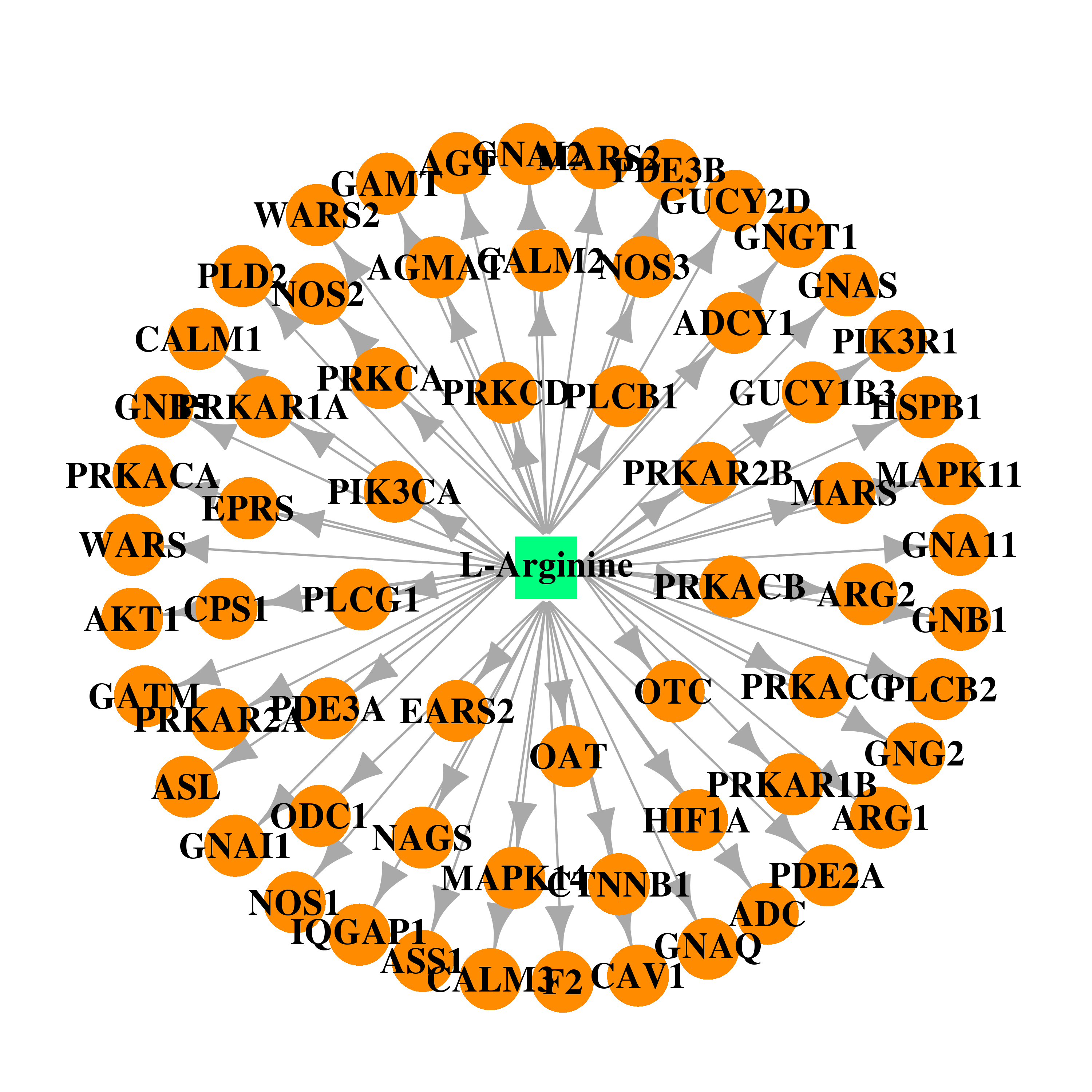 | 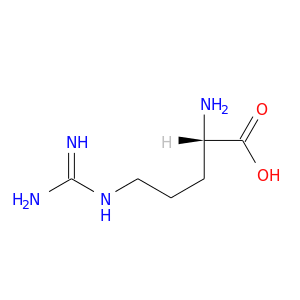 |
| DB00155 | v-akt murine thymoma viral oncogene homolog 1 | approved; nutraceutical | L-Citrulline | 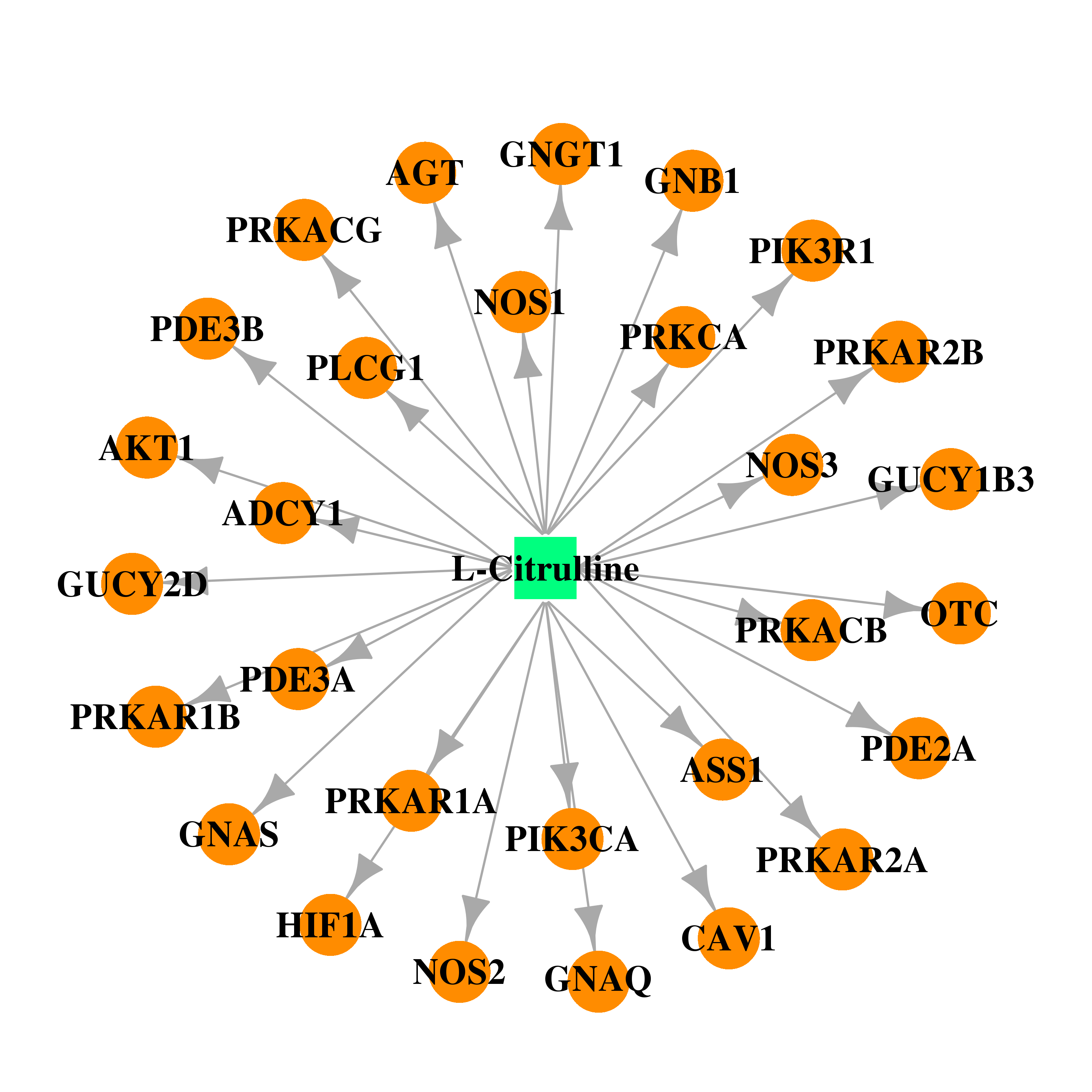 | 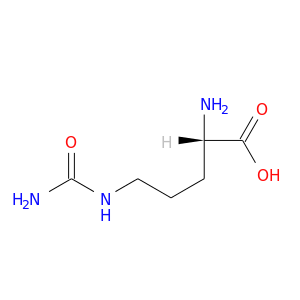 |
| DB00435 | v-akt murine thymoma viral oncogene homolog 1 | approved | Nitric Oxide |  |  |
| DB00131 | v-akt murine thymoma viral oncogene homolog 1 | approved; nutraceutical | Adenosine monophosphate |  | 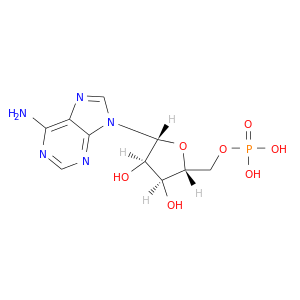 |
| DB00619 | v-akt murine thymoma viral oncogene homolog 1 | approved | Imatinib | 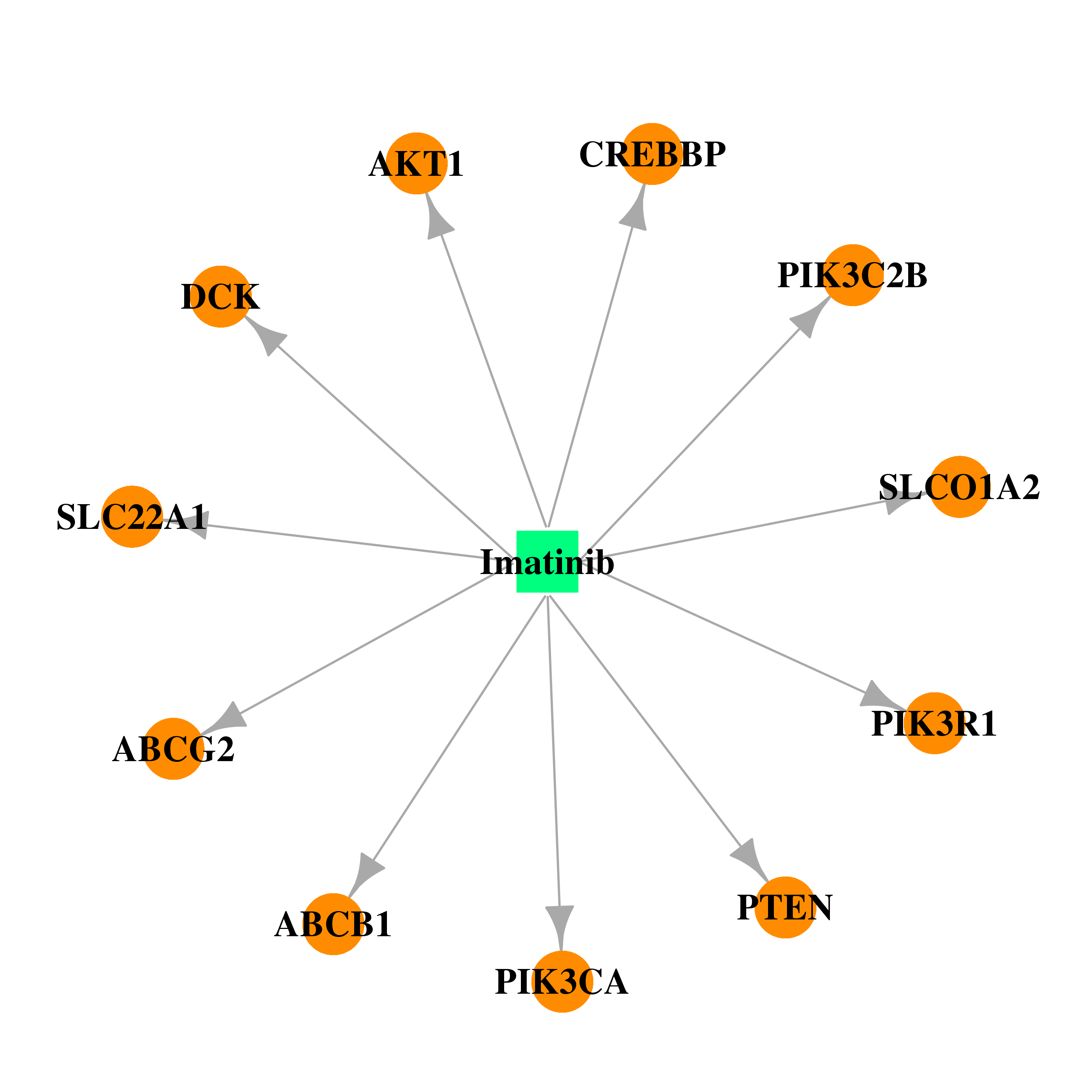 |  |
| DB00515 | v-akt murine thymoma viral oncogene homolog 1 | approved | Cisplatin |  |  |
| DB00441 | v-akt murine thymoma viral oncogene homolog 1 | approved | Gemcitabine |  | 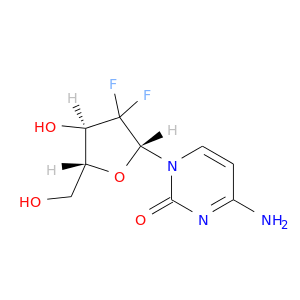 |
| DB00482 | v-akt murine thymoma viral oncogene homolog 1 | approved; investigational | Celecoxib | 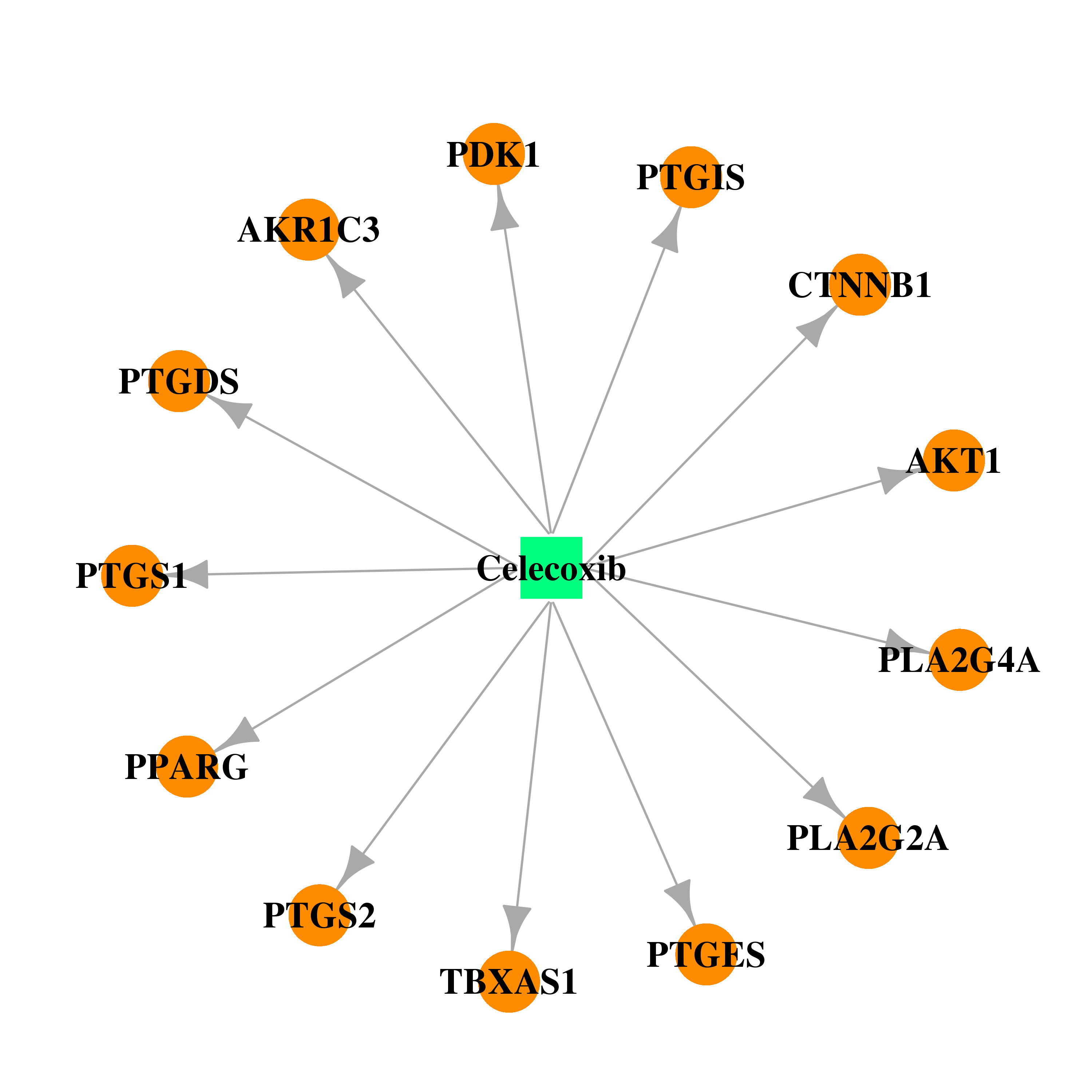 |  |
| DB00184 | v-akt murine thymoma viral oncogene homolog 1 | approved | Nicotine |  | 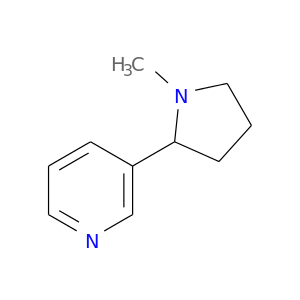 |
| DB01132 | v-akt murine thymoma viral oncogene homolog 1 | approved; investigational | Pioglitazone |  | 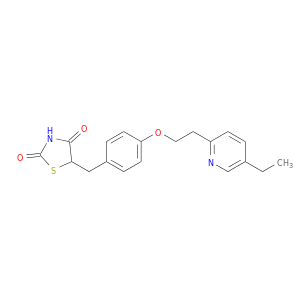 |
| DB00412 | v-akt murine thymoma viral oncogene homolog 1 | approved; investigational | Rosiglitazone | 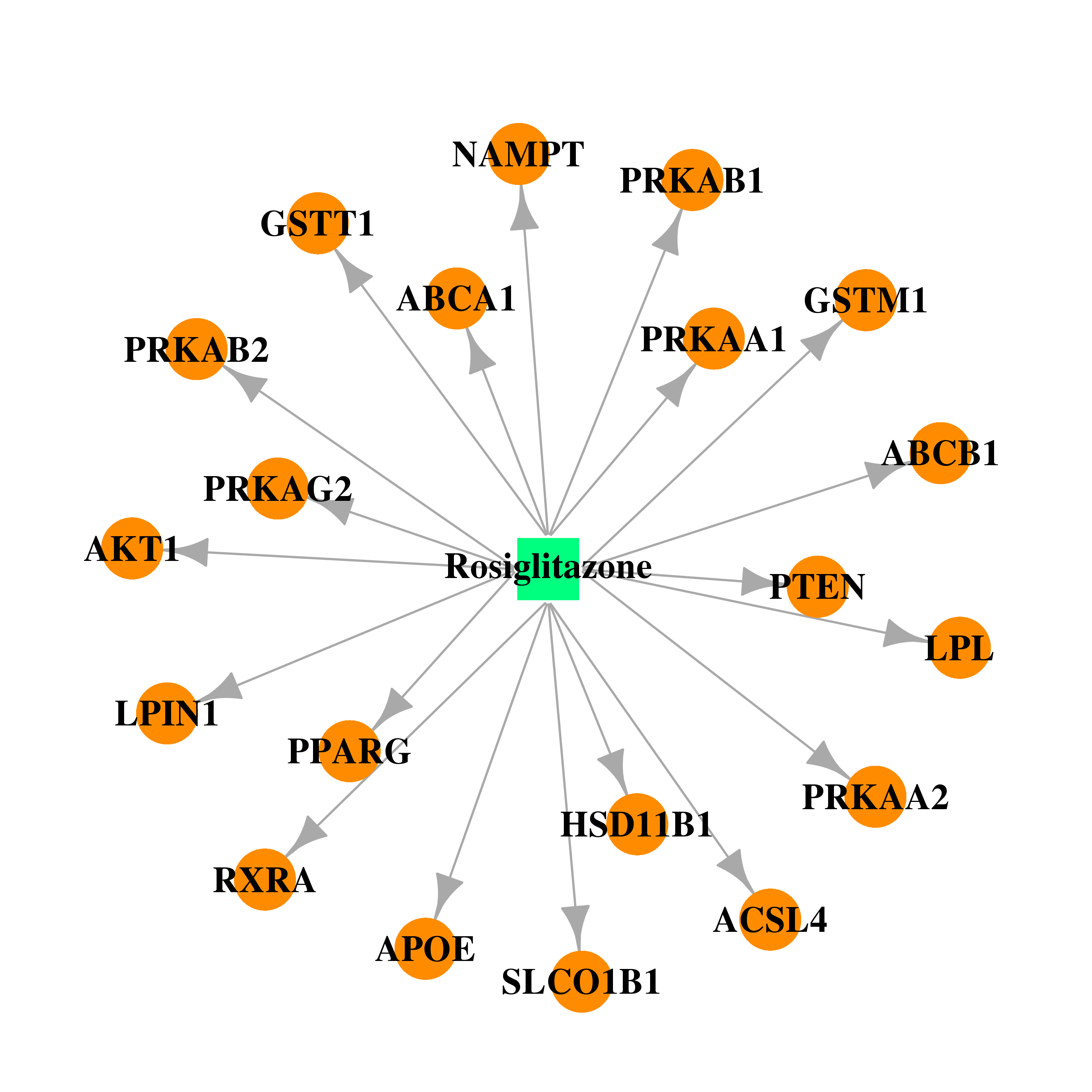 |  |
| Top |
| Cross referenced IDs for AKT1 |
| * We obtained these cross-references from Uniprot database. It covers 150 different DBs, 18 categories. http://www.uniprot.org/help/cross_references_section |
: Open all cross reference information
|
Copyright © 2016-Present - The Univsersity of Texas Health Science Center at Houston @ |






